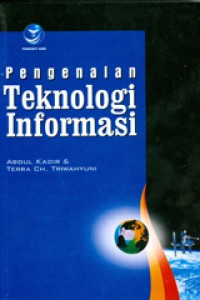Calendar Available schedule for the subject
Lecture 1: Introduction to 6.00
This lecture covers course expectations, introduces computer programming and its uses, and begins to familiarize you with concepts related to how programs work.
Topics covered during this lecture:
Lecturer suggest you to use these materials for this lecture. Reading material details are shown below

Pengenalan Teknologi Informasi
I. Abdul Kadir; II. Terra CH. Triwahyuni
ANDI , 2005

7.699
Pengenalan Teknologi Informasi
I. Abdul Kadir; II. Terra CH. Triwahyuni
ANDI , 2005
Lecture 2: Core Elements of a Program
This lecture covers the building blocks of straight line and branching programs: objects, types, operators, variables, execution, and conditional statements.
Lecture 3: Problem Solving
This lecture covers the use of iteration to build programs whose execution time depends upon the size of inputs. It also introduces search problems and brute force and bisection for solving them.
Lecture 4: Machine Interpretation of a Program
This lecture introduces the notion of decomposition and abstraction by specification. It also covers Python modules, functions, parameters, and scoping. Finally, it uses the Python assert statement and type 'str'.
Lecture 5: Objects in Python
This lecture introduces Python tuples, lists, and dictionaries, as well as the concept of mutability and how to avoid problems relating to it.
Lecture 6: Recursion
This lecture finishes the discussion of dictionaries, then introduces inductive reasoning and recursion. Examples include generating the Fibonacci sequence and solving the Towers of Hanoi problem.
Lecture 7: Debugging
This lecture starts with a brief explanation of why floating point numbers are only an approximation of the real numbers. Most of the lecture is about a systematic approach to debugging.
Lecture 8: Efficiency and Order of Growth
This lecture revolves around the topic of algorithmic efficiency. It introduces the random access model (RAM) of computation and "big O notation" as a way to talk about order of growth. It concludes with binary search.
Lecture 9: Memory and Search Methods
This lecture discusses how indirection is used to provide an efficient implementation of Python lists and other data structures. It also presents and analyzes the efficiency of selection and merge sort.